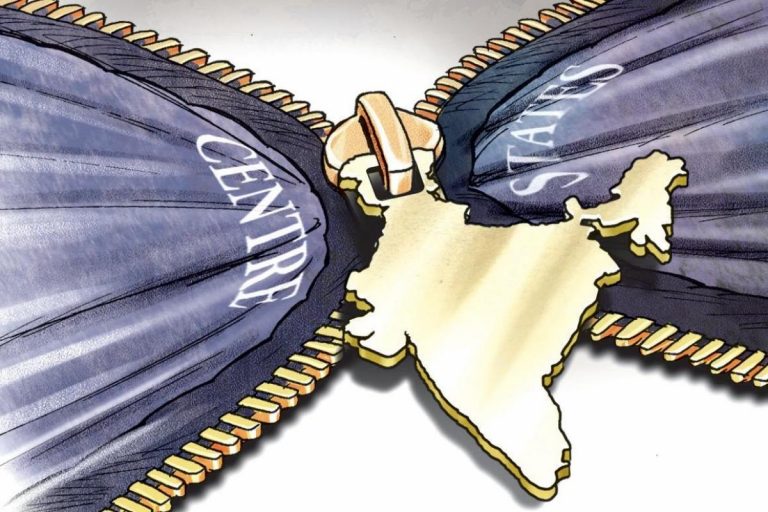
This article is written by Arya Mittal from Hidayatullah National Law University. The article analyses centre-state relations in India and their impact on good governance.
Table of Contents
Introduction
“Federalism is no longer the fault line of Centre-State relations but the definition of a new partnership of Team India.” Narendra Modi
The quote stated above is said by the Hon’ble Prime Minister of India, Shri Narendra Modi. Through this quote, the message of enhanced cooperative federalism is sought to be conveyed. It states that federal India is no longer a hindrance for better centre-state relations but rather it has given new hope to the mixed efforts of the Centre and states which may be referred to as cooperative federalism.
It is true that in the current times, states have a better role to play. They are included in the process of decision making. The same seems to be rational since they would be able to give a better picture of their respective areas for the reason that India is a diverse country. The two most prominent examples are NITI Aayog and Goods and Service Tax (GST) law.
Replacing the older Planning Commission where only the Union had a say, NITI Aayog was implemented by the current government where states have an equal role to play. It also boosts the morale of the states and holds them responsible for better decision making since they are now a part of the process. On the other hand, in 2017, India adopted a dual-structure GST model wherein both the Centre as well as the states have an important role. Both are empowered to levy and collect taxes. Additionally, the Centre also redistributes a part of its taxes among the states.
This way, a better relation of trust and faith can be witnessed between the Centre and the states. Through this research article, an attempt has been made to examine how far the centre-state relations have helped in strengthening cooperative federalism. Further, its impact on good governance has also been discussed.
Concept of centre-state relations
Part XI of the Indian Constitution specifically deals with centre-state relations. It has been bifurcated into legislative and administrative relations. Further, in Part XII, provisions related to financial relations are laid down. All three categories have been discussed in detail hereafter.
Legislative relations
Articles 245 to 255 deal with legislative relations between the Union and the states i.e. the Parliament and state legislatures. It discusses the extent of law-making powers given to the Union and states. On analysing the provisions, it is evident that the Parliament clearly has superseding powers as compared to state legislatures. The different provisions lay down the subject matters on which they can legislate, the effect of inconsistency between state and national law, residuary powers of the Parliament and many other provisions. It is this chapter that provides for Schedule VII which deals with the Union List, State List and Concurrent List.
Administrative relations
Articles 256 to 263 deal with administrative relations i.e. Central Government and various state governments. Though India is federal yet it has unitary features and thus in Article 256 itself, it is stated that the state governments should ensure that they abide by the laws made by Parliament and do not perform any executive or administrative function in contravention of the same. The Sarkaria Commission urged for cooperative federalism in case of administrative relations between the Centre and states to ensure better relations between the two. The same was important since there often arises the situation of different parties working at the Central and state levels which creates chaos and distrust thereby leading to inefficient administration.
Financial relations
Articles 264 to 293 of Part XII of the Constitution deal with financial relations between the Centre and state. Since India is a federal country, it follows the separation of powers relating to taxes and it is the duty of the Centre to allocate funds to the states. All such related provisions have been covered herein. The power of the Centre and states to levy taxes has been mentioned in Schedule VII. Further, it has many other provisions relating to levy and allocation of taxes by centre and states, grants to states, surcharges etc. A very recent example of financial centre-state relation is the Goods and Services Tax which is a dual structure tax. The tax is imposed and collected by both the Centre and state and then is distributed between the Centre and states. To simplify, CGST and SGST are received by Centre and state respectively and IGST is received by the Centre and redistributed between states. This is a precise example of cooperative federalism in the financial sphere.
Constitutional provisions relating to centre-state relations
Article 246
The provision deals with the subject matters on which the Centre and states can make laws. List-I deals with subjects on which the Centre can make laws. List-II deals with subjects on which states can make laws. List-III deals with laws on which both can make laws. This promotes legislative relations between the Centre and states.
Article 246A
The provision relates to GST. No authority had the power to levy GST since the same was not mentioned in the Seventh Schedule. Therefore, by the 101st Constitution Amendment Act, 2016, GST was made valid. It is important since India follows a dual GST structure in which both the Centre as well as the states have an important role to play.
Article 256
This provision makes it an obligation on part of the state governments to ensure compliance with laws made by the Parliament and also gives power to the Central Government to give directions to states as it may deem necessary. This makes administration easier since in the absence of such a provision, there would be conflicts relating to the validity of laws.
Article 258
The provision empowers the Centre to confer and entrust powers to a state even in matters where the Union has executive powers. It is believed that this provision is a tool for encouraging cooperative federalism since it would lead to more decentralised powers leading to a more federalist nation.
Article 269A
This provision relates to GST. It states that in case of inter-state supply, taxes i.e. IGST shall be levied and collected by the Central Government and will be distributed by the Centre to the states. As stated earlier, this is a reformative step as India is one of the very few countries which follow dual structure GST wherein both the Centre and states are involved.
Article 270
This provision deals with levying and distribution of taxes between the Centre and the states. These include those taxes which are collected by the Central Government in accordance with List-I. It prescribes for the formation of a Finance Commission and distribution of such percentage to every state as may be discussed by the commission.
Schedule VII
Article 246 has already been discussed and it is clear that three lists exist. These three lists are provided in Schedule VII of the Constitution. The Union list has 100 items, the state list has 61 items and the concurrent list has 52 items. Schedule VII also encourages cooperative federalism since it clearly distinguishes the legislative powers of the Centre and states but also provides certain subjects on which the opinion of both Centre and state should be taken into consideration.
Impact on good governance
A step towards cooperative federalism
This relationship of trust and faith between the Centre and states would lead India towards becoming a cooperative federal nation. The separation of powers on different matters would yield better results since it would not lead to the overlapping of activities and thus, a proper mechanism would be in place.
Harmony between Centre and states
The powers of the Centre and states have already been distinguished by the Indian Constitution. The provision for different lists ensures less confusion and conflicts between the Centre and states. Similarly, making laws of Parliament superior to that of state legislature ensures what prevails in case of inconsistency between the two. This would result in a streamlined mechanism where the states would not try to exceed their jurisdiction since the same has already been provided in the Constitution. This would result in lesser chaos and more harmonious relations between the Centre and states.
Better role of states
Certain provisions empower the states to take active participation in administrative, legislative and financial matters. For example, states are empowered to make their own laws in accordance with the State List. Similarly, they perform their administrative or executive functions without much interference from states. Also, they perform certain financial functions such as levying and collecting taxes. All these functions make the state autonomous and make India a better federal state.
Lesser burden on the Centre
Undoubtedly, better centre-state relations would lessen the burden of the Centre. A federal country divides the power between the Centre and states, which makes administration easy and more effective. Moreover, the states would be able to handle the situation better, however, the Centre might not be ready to accept so many regional disparities.
Inclusion of different sections of society
Division of powers between Centre and state in a country like India is very useful for the reason that there are regional disparities. Thus, it will not be possible for the Centre to handle the situation differently in every state according to the needs of the state. In this context, the role of the states becomes important since they would be able to handle the situation and govern the area according to the needs of the people which would ultimately lead to the inclusion of more sections of people in the mainstream society.
Impact of COVID-19 on centre-state relations
The COVID-19 has severely strained federal relations in certain aspects. In the context of finance, PM-CARES Fund was brought under the ambit of CSR, however, the same was not done for state-based funds. As a result, companies were more inclined to make donations to the Centre than states which led to a financial crisis for many states. Moreover, the GST dues of states not being paid by the Centre added to the problem.
In terms of administrative relations, many states felt that there has been discrimination by the Centre in terms of distributing medical equipment and vaccines, though the truth cannot be established.
Further, as regards the legislative relations, states were not consulted in many matters which were stipulated in the statutes; they were bound to follow the orders of the Centre which strained the relations between the Centre and states.
Major findings
- Centre-state relations can be trifurcated into legislative, administrative and financial.
- These centre-state relations have given a boost to cooperative federalism in India.
- In contemporary times, states are also included in the decision-making process which is healthy for the growth of the country.
- Cooperative federalism has had a positive impact on good governance as well as on the country.
Conclusion
India has a federal structure but also has huge regional disparities. In this sense, different authority at centre and state was necessary to cater to the needs of the country which would have not been possible if it had been a unitary government. Accordingly, certain provisions of the Indian Constitution provide for centre-state relations. These centre-state relations have been instrumental in developing the country as already discussed above. It has helped in better governance of the country, a better mechanism for administration and inclusion of different groups into the mainstream society.
Moreover, in contemporary times, an active role is played by the state which further leads to better administration. The different provisions of the Constitution have also played an important role since, without these provisions, there would have been a lot of chaos in relation to the distribution of powers between the Centre and states.
To conclude, it is hopeful that the centre-state relations strengthen with time and there is enhanced cooperative federalism since it is an important factor for determining the governance of the country.
References
- https://legislative.gov.in/sites/default/files/COI_1.pdf
- Mahendra Pal Singh, V.N. Shukla’s Constitution of India, (13th ed., 2017)
- Mamta Rao, Constitutional Law, (2nd ed., 2021
LawSikho has created a telegram group for exchanging legal knowledge, referrals and various opportunities. You can click on this link and join:
 Serato DJ Crack 2025Serato DJ PRO Crack
Serato DJ Crack 2025Serato DJ PRO Crack






 Allow notifications
Allow notifications
